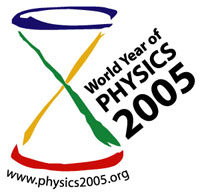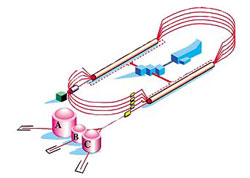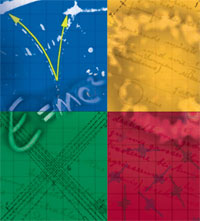|
|
|
|
|
2005 JLab News Release
|
||||||
2005: The World Year of PhysicsJanuary 14, 2005In 1905, Einstein wrote five papers that changed the way we look at physics. This year marks the 100th anniversary of Albert Einstein's "miraculous year," and the international physics community is celebrating this anniversary with events, programs and activities that celebrate Einstein, his ideas and his influence on life in the 21st century. 
In 1905, a young patent examiner in Bern, Switzerland with a degree in physics wrote five papers that were all accepted and published in Annalen der Physik, a respected German physics journal (one of the papers, though submitted in 1905, was published in 1906). These papers introduced ideas that transformed the field of physics, providing physicists new avenues of exploration and new ways to pursue them. Fast forward to 2005, where the international physics community is celebrating the 100th anniversary of Albert Einstein's "miraculous year" with a year-long celebration of Einstein, his ideas and his influence on life in the 21st century. Jefferson Lab (JLab) is joining this celebration with events, programs and activities open to the general public. Read on to find out how Einstein's work is important to JLab and how you can take part in the celebration. Brownian Motion Einstein's paper on Brownian motion not only explained the phenomenon, it also offered an experimental test for the theory of heat and helped to establish the modern view that all matter and material objects are composed of individual atoms and molecules attracted to one another by the fundamental forces of Nature. Scientists at JLab are continuing this work by studying the basic building blocks of individual atoms, with particular interest in how protons and neutrons combine to form an atom's nucleus (what physicists call the atomic nucleus). Experiments at JLab are carried out with CEBAF, the Continuous Electron Beam Accelerator Facility. The accelerator propels a nearly continuous beam of electrons at an experimental target. These electrons strike individual atomic nuclei in the target, and physicists analyze the reaction to learn about these nuclei, the protons and neutrons inside the nuclei, the quarks inside the protons and neutrons, and the forces holding all these particles together. 
See how the accelerator works at our virtual vistor's center. The Photoelectric Effect In experiments at JLab, as an electron from the electron beam approaches the nucleus of an atom inside an experimental target, the electron may emit a photon. This photon is what actually strikes the nucleus. And in other experiments, physicists may choose to amplify the number of photons by sending the electron beam into a crystal or some other medium to transform it into a beam of photons with precisely known characteristics. The collisions of photons with an experimental target tell us something about the atoms we're studying. "You've got a particle coming in, something at rest, and two things going out. In our case, sometimes one of the things going out has been excited, and we learn about its internal structure as well as about its size and shape by doing that," says Larry Cardman, JLab Associate Director, Physics Division. He says these collisions are a lot like what happens on a pool table as billiard balls collide. To analyze what will happen to colliding balls on a pool table, physicists can use classical mechanics, which use Newton's laws of motion. But these laws fail to describe the motion of subatomic particles. To describe what happens on that scale, physicists need to use quantum mechanics. "The physical theory we use to describe the systems we're studying, because they are small, is quantum mechanics. But because we're studying the systems with reactions that involve large amounts of energy and particles moving at very high velocities, the theory we use to describe the systems is relativistic quantum mechanics, which merges Heisenberg and all of quantum mechanics with Einstein's theory of relativity," Cardman says, "If you're looking at the reactions we do at the energies we do them, you can't do it without invoking and using, every day, the special theory of relativity." 
DOE Office of Science celebrates 2005 World Year of Physics. The Special Theory of Relativity "Einstein's contributions to physics in the year 1905 are at the core of charged particle accelerators and colliders. These machines have ushered in the exciting productive era of high-energy particle and nuclear physics in the twentieth century," says Swapan Chattopadhyay, JLab Associate Director, Accelerator Division. "Our electrons travel extremely close to the velocity of light, the realm of special relativity," Chief Scientist Thomas says, "So basically, without Einstein, we wouldn't have the ability to deal with the electrons or know about the photons they emit and be able to use them for physics. It's pretty clear that Einstein, in 1905, set the groundwork for everything we do here." In particular, Einstein was the first to declare a universal speed limit. Inherent in the special theory of relativity is the idea that nothing may travel faster than the speed of light. "And in our case, our electrons are moving at about the speed of light in the accelerator. That means that particles going through our accelerator are traveling at practically the same speed in every recirculation pass. Without that, CEBAF would not work, because the particles would be traveling at different speeds, and you couldn't keep everything in phase," says Andrew Hutton, Deputy Associate Director, Accelerator Division. Physics Associate Director Cardman adds, "Essentially, everything about the accelerator and the experiments we do, you can't analyze, understand or interpret them, or even make the accelerator work without understanding the special theory of relativity," says Larry Cardman, JLab Associate Director, Physics Division. Physicists continue to use, test and further elucidate the theories first introduced by Einstein a hundred years ago. Here at JLab, we're honoring his work by exploring the inner realms of matter that couldn't be reached in Einstein's time by taking to heart and utilizing his contributions to science. JLab is offering a number of activities and programs open to the general public on Einstein's science and JLab's science. See the calendar of events for in-depth descriptions of the activities. Schedule of JLab's 2005 World Year of Physics Events to date:
February 8
February 16
March 16
March 22
April 16
May 4 You can find more information about Einstein and the World Year of Physics at the following sites: Thomas Jefferson National Accelerator Facility’s (Jefferson Lab’s) basic mission is to provide forefront scientific facilities, opportunities and leadership essential for discovering the fundamental structure of nuclear matter; to partner in industry to apply its advanced technology; and to serve the nation and its communities through education and public outreach. Jefferson Lab is a Department of Energy Office of Science research facility managed by the Southeastern Universities Research Association. content by Public Affairs maintained by webmaster@jlab.org updated January 14, 2005 |